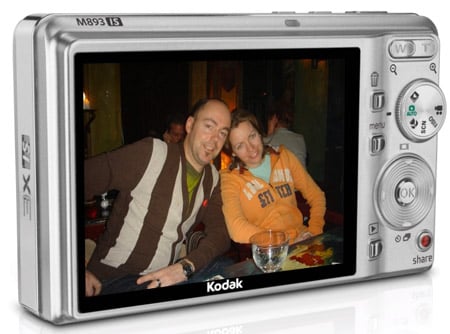This article is more than 1 year old
Kodak EasyShare M893 IS compact camera
Cheap cheerful compact
The back of the camera features the 2.7in LCD screen; a zoom rocker control; a dial for selecting any of the various modes, including auto, macro, scene, ISO and movie; a delete button; a Menu button plus a five-way navigation control; a playback button and a tiny red Share button. The latter can be used with Kodak’s EasyShare software for tagging images for printing or emailing. At the bottom is a cover for the battery/memory card.
Using the M893 is quite straightforward. There’s plenty of on-screen help in the form of short text descriptions which inform you about the function you’ve selected. Press the Menu button and you can select a few settings, including image size, which runs from 8.1 megapixels in 4:3 format down to 1.2 megapixels in 4:3 format.

The 2.7in LCD isn't made for bright light conditions
There are also two 16:9 formats for displaying images on a widescreen monitor or HDTV screen with image sizes of 6.1 megapixels and 2.1 megapixels. You can also set the time exposure from zero to 4.0 seconds; the colour mode; white balance; autofocus zone; and ISO speed: auto, 80, 100, 200, 400, 800 and 1600. In auto mode, the ISO runs from 80 to 400. The movie options are 640 x 480 (VGA) at 15 f/s, and 320 x 240 (QVGA) at 30 f/s. The scene or programme settings are displayed as a series of icons which you scroll across – as you do this a short text description is displayed. The 18 scene selections include portrait, sports, landscape, sunset and panorama.
Switch-on is smooth and slick, and the M893 is ready to go in just a few seconds. Follow the late Mr Eastman’s advice and you can’t go wrong, but there were a number of small things that made the user experience less than perfect. This is not the fastest camera around, and the auto focus system can take a while to settle down.
Then there’s the flash control button on the top of the camera. On the face of it, this is a more convenient location than the back of the camera, which is where most manufacturers place the flash control. But it proved all too easy to inadvertently switch it on or off when pressing the shutter button. The camera mode dial moves freely - rather too freely for our liking, because we found that if you whipped the camera out of your pocket you had to check that the dial hadn’t been inadvertently moved. In one case, we fired off a set of shots only to find that we were now in the High ISO mode.
